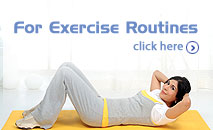 Are you confused with all the advertisements, infomercials and headlines about the proper diet, amount of exercise and optimal physical performance levels necessary for good health and fitness? Do all these proclamations floating around bog you down and come in the way of your well-being?
Are you confused with all the advertisements, infomercials and headlines about the proper diet, amount of exercise and optimal physical performance levels necessary for good health and fitness? Do all these proclamations floating around bog you down and come in the way of your well-being?
Here are some myths that should be dispelled. To achieve good health, steer clear of all the confusion, which may be present in your mind, and reach your fitness goals as safely and efficiently as possible.
Both cardiovascular exercises and strength training exercises are necessary to promote weight loss. Cardiovascular exercises help burn calories, and strength training exercises increase the body’s metabolism and also tone the muscles. Moreover, calories burned while weight training are more likely to come from fat rather than from glycogen stores. So, include both forms of training to get effective, long-term results.
Exercising the same body part every day is the fastest way to cause injuries. To build strength, you need to work your muscles to the point of exhaustion – but then you need to give those muscles a day of rest to recover from the training. “Over-training” can cause serious injuries and discomfort. That is why it is necessary to work the muscles every alternate day to provide for recuperation from muscle fatigue.
It is widely believed that the abdominals should be trained on a daily basis to achieve maximum effect. The fact is, abdominals can be over trained just like any other muscle group. When abs are trained too frequently, the recovery process is shortchanged, resulting in diminished muscular development. The abdominal muscles, like any other, need adequate rest and recuperation. Alternate your days for doing abdominal exercises to achieve maximum benefit. Remember, crunches will only tone your abdominal muscle, so if you want to get rid of the fat around your stomach, you have to create a calorie deficit by burning more calories than you consume.
To improve fitness and especially to lose weight, you need to combine a nutritious diet with exercise. If you follow a low fat, healthy diet and combine it with regular exercise, you will find that the body fat percentage will decrease, resulting in increased overall health.
The truth is exactly the reverse. The less fit you are, the greater the relative improvement will be. If you are overweight or out of shape, you are likely to burn more calories per minute than someone who is in shape. It’s a simple law of physics -- you’re doing more work, because you are making that much more effort with your size or fitness level.
Gently stretching and warming up your muscles before you exercise is the number one defense against a variety of painful sports injuries, including tendonitis. Not only do you prevent injuries, but you also improve the range of movement required for the activity to follow.
Muscle and fat have two separate and distinct properties. Muscle cannot turn into fat and fat cannot be converted into muscle. When you stop exercising the trained muscle eventually gets back to its pre-exercise level. When you stop weight training, the muscles shrink because they are not being challenged.
Not true. There is no one best time to exercise. The best time is the time that appeals to you and fits into your schedule. Some people would love to jumpstart their day with a morning workout, while others believe that exercising after the workday is a great way to eliminate stress and feel energized.
This is the opposite of what’s true. You need to drink water before, during and after your workout. Water is the most important nutrient to an exercising individual. Restricting fluids during exercise, especially in hot weather, can cause severe cramps, headaches, dehydration and can also limit performance. Drink water every 10 to 15 minutes during exercise to help replace body fluids lost through perspiration.
This myth is really destructive. Pain is your body signaling that something is wrong. If you feel pain during a workout, you should not push past it, you should slow down and even stop your workout. To increase muscle and develop endurance you may need to experience a slight level of discomfort, but that’s not pain. “No pain, no gain” is no good when it comes to developing a lifelong fitness plan.
Despite the short-term effectiveness of many fad diets that advocate fat-free food consumption without heed to overall caloric intake or consumption of nutritious foods; following this food pattern can never get you long term, sustained results.
One big reason: low-fat and fat-free foods are loaded with sugar and sodium to disguise their lack of taste. Eating them not only keeps you away from eating real foods, but recent statistics show that you are more likely to consume twice as much food when you know it is non-fat, to keep you feeling satisfied.
Another reason: Even though you have lowered the fat intake, the high carbohydrate content of these foods fuels fat-storage in the body. Processed foods contain empty calories and consuming excess carbohydrates means that extra calories are being stored in the body.
Though crash dieting can result in large amounts of weight loss, it is muscle mass, glycogen stores and water, not excess body fat that is lost. This can impair an individual’s endurance and cause poor performance. Other problems associated with crash diets include electrolyte imbalances, calcium deficiency, iron deficiency, anemia, and vitamin and mineral deficiencies. It is important to be sensible about modifying a diet to lose weight. A person should lose no more than two pounds per week. If you reduce your caloric intake by 500 calories per day and increase your activity to burn an additional 500 calories per day, you could lose two pounds by the end of one week.
There is no evidence to show that consuming excess amounts of protein will increase muscle strength or size. In fact, protein consumed in excess of what the body needs will be converted to fat.
- Benefits of Exercise
- Exercise and the Heart
- Exercise and the Bones
- Exercise and Hypertension
- Exercise Excuses and how to beat them
- Over Exercising is bad for you
- Kids gotta Exercise too!
- What is Obesity
- Fitness Triangle
- Running, Skipping and Cycling
- Walking
- Swimming
- Common Fitness Myths
- Evaluate your Fitness Quotient
- Wellness Tools and Charts



